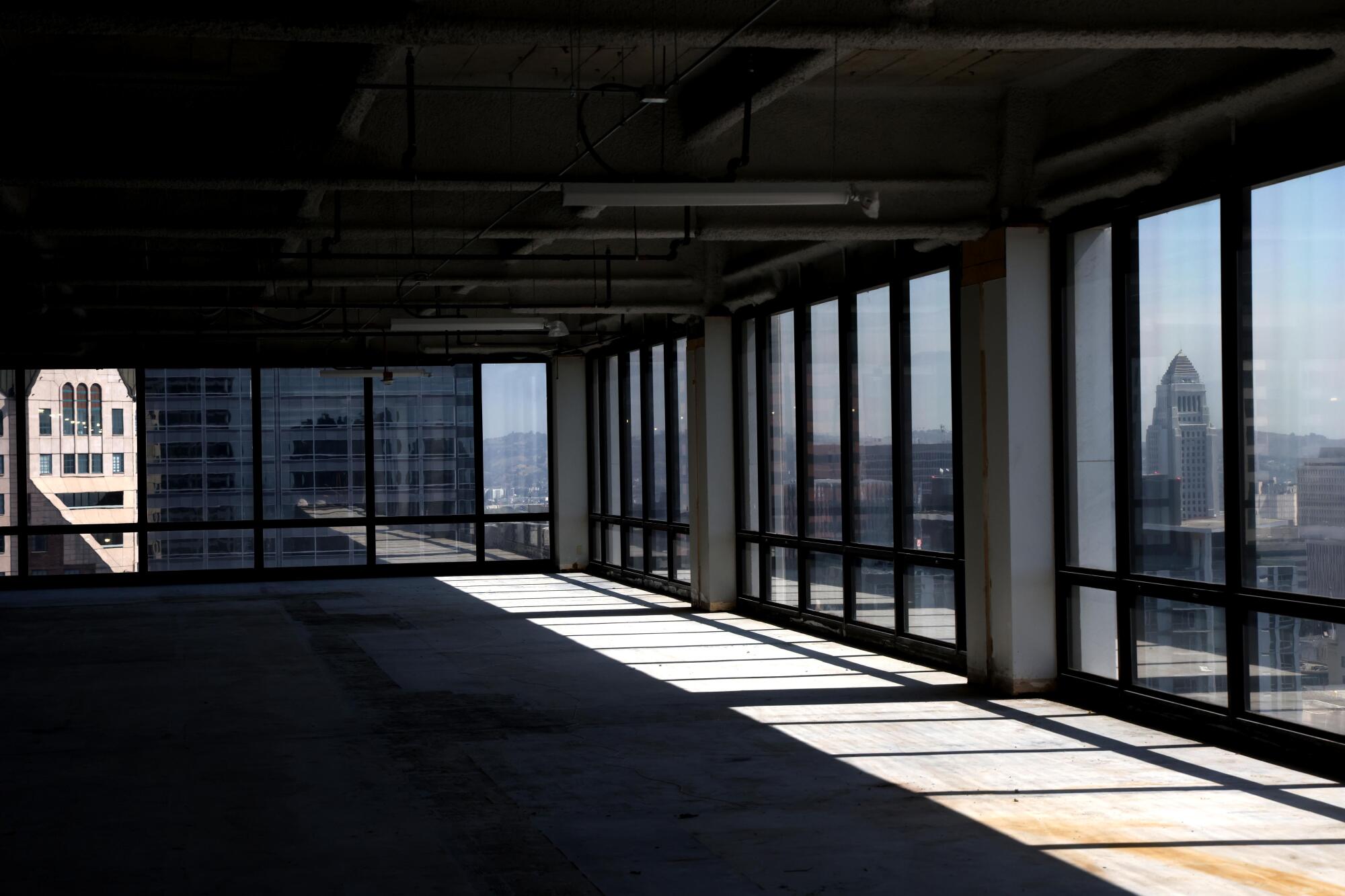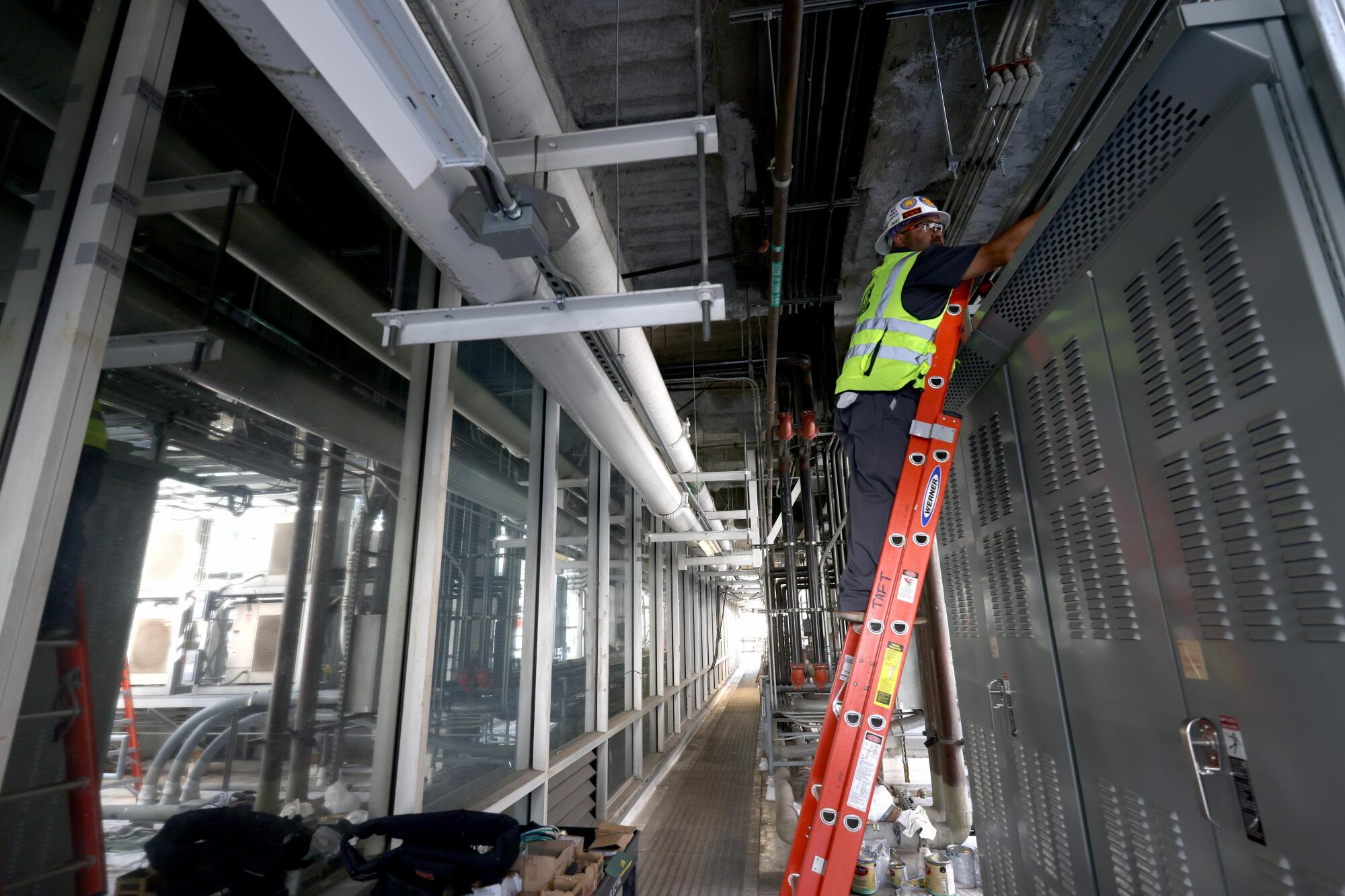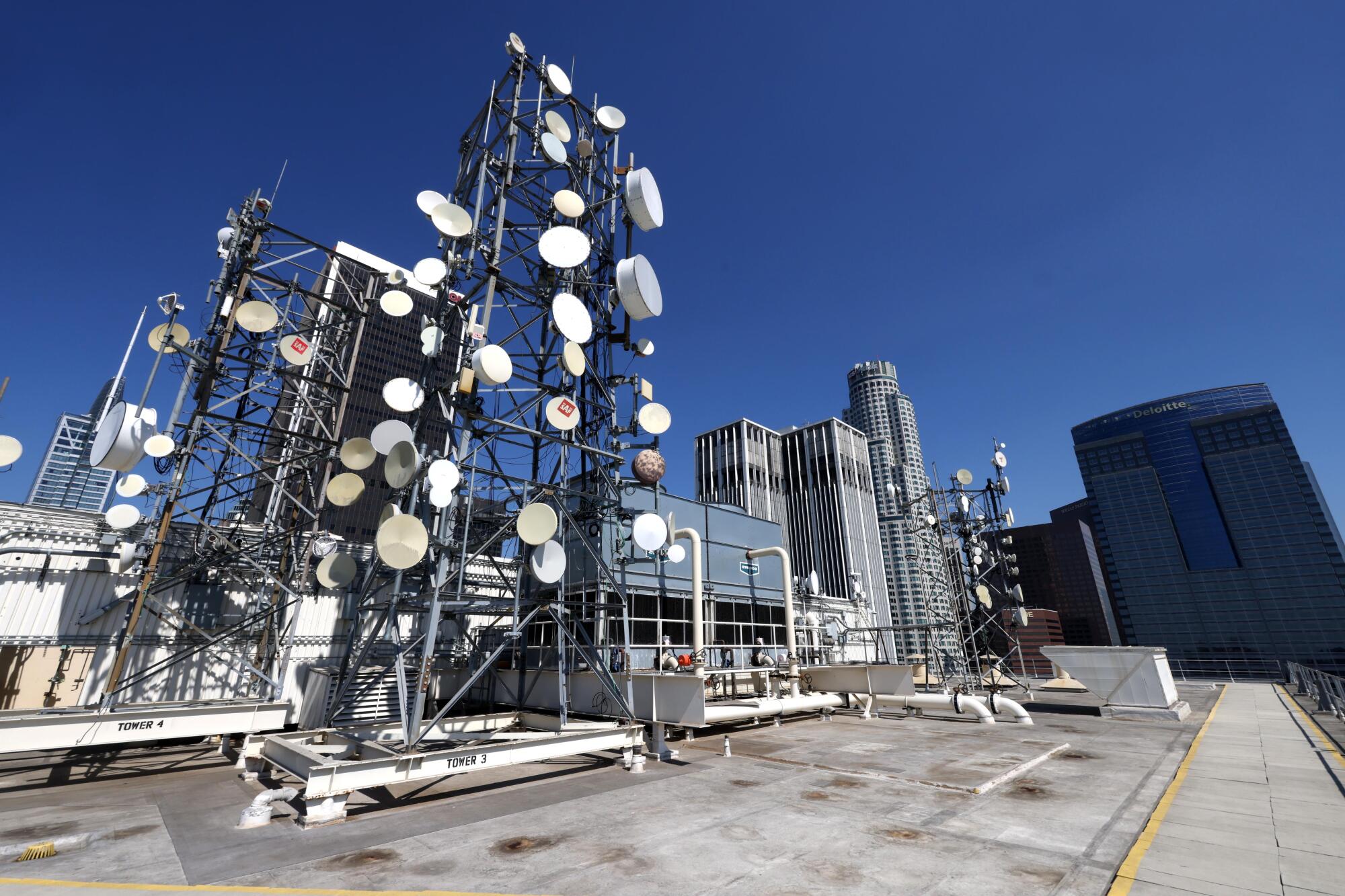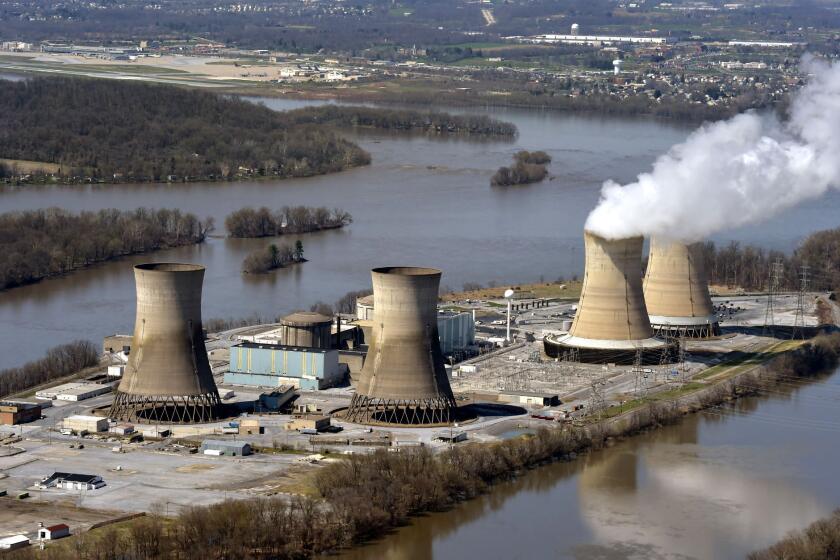
- Share via
Where Wilshire Boulevard begins in downtown Los Angeles, thousands of miles of undersea fiber-optic cables disappear into an ordinary-looking office tower.
One Wilshire is the mother of all data centers in the West, a discreet terminus for major digital links between Asia and North America that help sustain the world’s bottomless need for data storage and computing power.
Once a workplace for lawyers and other white-collar types, the mid-century office building‘s 30 floors are now stuffed with cables, pipes, coolers, generators and other equipment needed to support online functions that power the economy and our private lives at unmatched speed. (If you could get inside — and you can’t — the building’s internet connection would give you a split-second jump over others when tickets for the World Series or a concert went on sale.)
A new luxury residential tower in downtown L.A. reflects an unusual disconnect: While office rentals continue to struggle, downtown as a residential center is thriving.
“We’re all consumers of data centers,” whether it’s scrolling social media on our smartphones, watching streaming services such as Netflix on TV or ordering a dog food delivery on our laptops, said Maile Kaiser, chief revenue officer of data center operator CoreSite, the largest tenant in One Wilshire. “Any content that we make is stored in a data center.”

The digital transformation of One Wilshire, which is nearing completion with the recent departure of one of the last conventional tenants, is part of a larger real estate boom underway across Los Angeles County.
As artificial intelligence and cloud storage hoover up more and more space on the nation’s computer servers, real estate developers are racing to build new data centers or convert existing buildings to data uses. The need is so great, they’re having a hard time keeping up with demand as businesses in search of secure spots for their servers rent nearly every square foot that becomes available. Large-scale backup generators to keep the 24/7 operations running in the event of a power failure are in short supply.
Construction of new data centers is at “extraordinary levels” driven by “insatiable demand,” a recent report on the industry by real estate brokerage JLL found.

“Never in my career of 25 years in real estate have I seen demand like this on a global scale,” said JLL real estate broker Darren Eades, who specializes in data centers.
The biggest drivers are AI and cloud service providers that include some of the biggest names in tech, such as Amazon, Microsoft, Google and Oracle.
With occupancy in conventional office buildings still down sharply from the effect of the COVID-19 pandemic and property values falling, data centers represent a rare ripe opportunity for real estate developers, who are pursuing opportunities in major markets such as Los Angeles and less urban locales that are served by plentiful and preferably cheap power needed to run data centers.
“If you can find a cluster of power to build a site, they’ll come,” Eades said of developers.
Construction is taking place at an “extraordinary” pace nationwide and still not keeping up, the JLL data center report said. “Vacancy declined to a record low of 3% at midyear due to insatiable demand and despite rampant construction.”
Development increased more than sevenfold in two years, with the pipeline of new projects leveling off in the first half of 2024, a potential signal that the U.S. power grid cannot support development at a faster pace.

But when projects currently under construction or planned are complete, the U.S. colocation market, in which businesses rent space in a data center owned by another company for their servers and other computing hardware, will triple in size from current levels.
With the release of OpenAI’s ChatGPT in November 2022, AI-driven products and platforms became ubiquitous overnight, JLL said. The huge amount of computing power required by generative AI is having the greatest impact on data storage, followed by continued cloud growth.
Real estate investors and landlords are being drawn into the market because demand from tenants is high and they are likely to renew their leases after shouldering the costs of setting up data centers.
The owner of the shuttered Three Mile Island nuclear power plant says it plans to restart the reactor under a 20-year agreement.
“They invest in their space and in your space and they tend to stick around longer,” said Mark Messana, president of Downtown Properties, which owns offices in Los Angeles and San Francisco. “As we all know, the office market is struggling a little bit, so it’s nice to be able to have some data customers in the mix.”
Rents at One Wilshire, for example, can be double what they are at newer downtown office high-rises, according to real estate data provider CoStar.
Servers, power lines and cooling equipment have almost completely taken over the building that was once a prestigious address for businesses. There are electric conduits running up stairwells and racks of cables hanging from ceilings. Two elevators were removed so the empty shafts could hold water pipes used to help keep the temperature cool enough for the heat-producing servers.

The recent departure of a law firm that had been in the building more than 50 years cleared out five floors that will quickly be re-leased to data tenants, said Eades, who represents the landlord.
Challenges in the rapidly expanding data center industry include finding trained workers to staff facilities around the clock, seven days a week.
“These are high-paying, high-demand jobs,” Eades said, with employers scooping up computer science and engineering majors out of college.
The job can take a toll on workers, though. There are long hours in enclosed buildings with limited contact with the outside world, and working night shifts “can be challenging for employees to endure,” the report said. Thirty percent of data center workers quit in the last year, citing unhappiness with their work/life balance, the JLL report said.
Filling second- and third-shift jobs can add an additional month or more to the hiring process because of applicants’ reluctance to work off hours, even when they pay more than day jobs, according to the report.
Southern California suffers from a shortage of new data centers, as new users enter the market daily and demand continues to grow, JLL said. That’s spurring development in smaller markets in Los Angeles County such as Vernon, which has its own power plant that provides electricity at cheaper rates than are found in surrounding cities.
Monterey Park, which is served by Southern California Edison, is also “a hot area,” Eades said, where two new developments will be announced in the next month or so.
Graffiti artists made Oceanwide Plaza in downtown Los Angeles infamous. But a far more complex question looms over the real estate catastrophe: Can it be salvaged?
Power demand for computing is growing so intense that it threatens to strain the nation’s electrical grid, sending users to remote locations where power is plentiful and preferably cheap.
Data center developers are working in Alabama, the Dakotas and Indiana, “traditionally states that wouldn’t have data centers,” Eades said.
A company called CalEthos plans a data center near the south shore of the Salton Sea in California’s Imperial County. Electricity for the data center’s servers would come from the geothermal and solar plants built near the site in an area that has become known as Lithium Valley. That data center would cover land the size of 15 football fields and require power that could support 425,000 homes.
Data centers have long been big power users. But the specialized computer chips required for generative AI use far more electricity because they are designed to read through vast amounts of data.
The new chips also generate so much heat that even more power and water are needed to keep them cool.
By 2030, data centers could account for as much as 11% of U.S. power demand — up from 3% now, according to analysts at Goldman Sachs. Last week, a deal was announced to reopen the infamous Three Mile Island nuclear power plant in Pennsylvania in order to power Microsoft’s data centers performing cloud computing and AI programs.
The plant, the site of he nation’s worst commercial nuclear power accident in 1979, was closed five years ago because it was losing money. Microsoft has agreed to buy power from the plant for 20 years if regulators approve its revival.
“There will always be a need for a data center,” Kaiser said. “Everybody loves to create their content now, whether it’s a photo or a video or online shopping, we’re all doing it. Now we’ll see what we do with AI.”
Times staff writer Melody Petersen contributed to this report.
More to Read
Inside the business of entertainment
The Wide Shot brings you news, analysis and insights on everything from streaming wars to production — and what it all means for the future.
You may occasionally receive promotional content from the Los Angeles Times.














